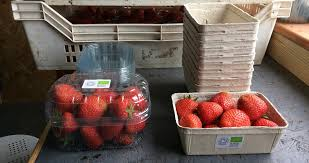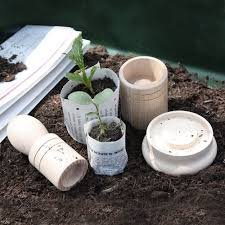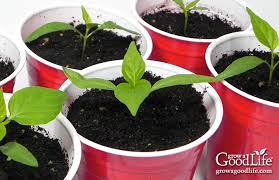5February 2015 | Written by Benedict Vanheems
As gardeners, we often look for ways to make the most out of what we have. Whether it’s saving money or reducing waste, recycling materials for seed sowing is a satisfying and resourceful way to start your gardening season.
Recycling waste into garden tools gives a sense of accomplishment, knowing that we’ve repurposed items that might otherwise have been discarded. It’s also simple! A quick look through the recycling pile can yield useful pots, seed trays, and more—all ready for a second life in the garden.
Recycled Containers for Seed Sowing
Seed sowing is the perfect place to begin recycling in the garden. You’ll find that many common items can be repurposed immediately with minimal effort, while others may just need a few tweaks before they’re ready for use. Not only can you save money, but you can also add a bit of fun to the process by decorating containers to suit your style.

Old Yogurt Pots
Yogurt pots are great for sowing smaller clusters of seeds or even larger seeds individually. To get started, punch some drainage holes into the bottom using a sharpened skewer or a power drill. This ensures that excess water can drain away and prevents the seeds from rotting.
Fruit Punnets
The clear plastic trays often used for fruits like raspberries make excellent miniature seed trays. Many of these trays already have drainage holes, so they’re ready for use without modification. They can also double as mini-greenhouses for sprouting seeds, allowing warmth and humidity to encourage germination.

Toilet Roll Tubes
Toilet roll tubes offer a unique benefit—they provide extra root depth, which is perfect for vegetables with deep roots, such as peas, beans, and corn. Simply pack them tightly into a tray to prevent collapsing when watered. Best of all, these tubes can be planted directly in the soil as the cardboard decomposes naturally.
Polystyrene Cups
Old polystyrene cups (such as those used for hot drinks) are another excellent choice for seed starting. Their insulation helps protect the roots from cold temperatures, and they are the right size for young plants. Punch several holes in the base for drainage before use.
Making Paper Pots
For a sustainable alternative, you can make your own paper pots using old newspapers. If you don’t want to invest in a paper pot maker, you can easily create one by folding a newspaper page lengthwise, rolling it around a toilet roll tube, and securing the ends to form a bottom. After removing the tube, you’ll have a sturdy pot ready for sowing.

Labeling Your Seed Trays
One common challenge with seed sowing is forgetting which seedlings belong to which variety. The solution? Label everything! You can create your own labels by cutting strips from yogurt pots or reusing wooden ice cream sticks. It’s an easy way to stay organized and avoid confusion.
For direct sowing in the ground, try using wooden battens or even pruned branches as row markers. Not only do they help with labeling, but they also look attractive in the garden.
Creating Miniature Cloches
A little warmth can make a huge difference in seed germination. You can create a mini-greenhouse effect by covering seed trays or individual plants with clear plastic or glass. Old glass panes, for example, can be placed over trays, while clear plastic bottles can be cut in half to create miniature hot houses. These simple covers trap heat from the sun and encourage faster seedling growth.
Another tip is to use reflectors to help seedlings get enough light. Aluminum foil, placed shiny-side out on a vertical surface opposite a window, reflects light back onto the plants. This reduces the tendency for seedlings to lean toward the light, keeping their growth balanced.
Final Thoughts
Recycling for seed sowing is an easy and cost-effective way to kick off your gardening season. By using everyday items, you not only save money but also reduce waste. So, before you head out to buy new pots or trays, take a look at your recycling bin—you may already have everything you need for your next batch of seedlings.
Feel free to share your own ideas for repurposing materials in the garden below!
